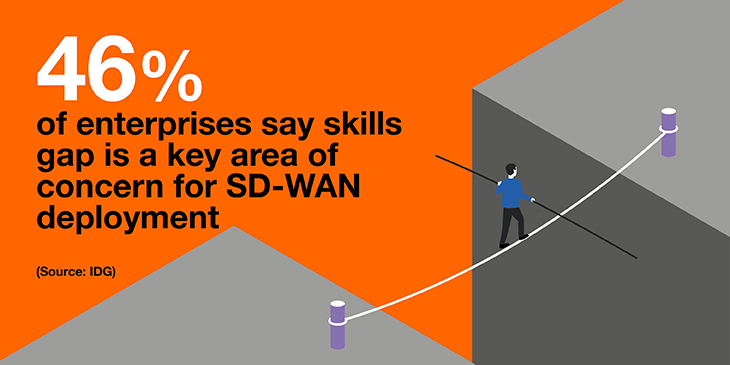IDC forecasts that the total SD-WAN market will continue to grow at a compound annual growth rate of 30.8% from now until 2023 to reach $5.25 billion. According to IDC, enterprises are moving to SD-WAN to support their digital business, in particular SaaS applications and multi/multi-hybrid cloud usage. In addition, they are looking for an easier way to manage multiple connection types across WANs to improve application performance and the end-user experience. Both of these are tied to ongoing digital transformation.
"Driven by the unrelenting imperative of digital transformation and the enterprise embrace of cloud and multicloud, network modernization is extending across WANs worldwide," explains Brad Casemore, Research VP at IDC. "This is not surprising when one considers that the WAN is essential to business outcomes at branch locations and remote sites, which are often where business takes place, whether in the form of employee productively or customer satisfaction.”
Sony embraces SD-WAN
Multinational Sony is forging a strong path with its global SD-WAN infrastructure and has chosen Orange Business as a key partner in its transformation, using Flexible SD-WAN to integrate its film and electronics business units with a single, global network.
“Orange innovation, integration capabilities and international network are the catalysts that will allow us for the first time to bring our regional operating companies under one umbrella,” said Makoto Toyoda, CIO, Sony Group.
“Only Orange could deliver a platform with the scale and scope to cover all the moving pieces of our international business. It’s a transformative move on our part that opens the way for us to embrace new forms of IT innovation, which will push the company forward,” adds Makoto Toyoda.
In the financial sector, enterprises are re-architecting their legacy WANs with SD-WAN to exploit traffic-routing segmentation features, according to IHS Markit’s Network Equipment Market Tracker. “This ensures that traffic containing sensitive customer data is separated from other network traffic, increasing data security and aiding in demonstrating payment card industry (PCI) compliance,” explains Josh Bancroft Senior Research Analyst at IHS Markit.
According to IHS Markit, the SD-WAN market, including appliances and the control of management software, jumped 23% in the second quarter of 2019. The analyst firm says that moving forward there will be increased deployment of SD-WAN appliances in the homes of remote and mobile employees, which will further boost the market. In the healthcare sector, for example, SD-WAN can provide greater flexibility, security and automation for teleradiology. The beauty of SD-WAN is it can be used alongside or on top of an existing network infrastructure to hook up remote locations, allowing doctors and radiologists to view images and collaborate.
Hurdles to SD-WAN adoption
As enterprises look for new ways to improve their network infrastructure, SD-WAN is becoming a priority investment. According to recent IDG Research, SD-WAN adoption has increased from 35% to 54% with 90% of enterprises surveyed actively researching, piloting, using or upgrading their existing SD-WAN.
Despite this, there are still areas of anxiety around SD-WAN deployment. The skills gap remains a top area of concern, according to IDG’s research, with 46% of enterprises putting it at the top of their adoption worries. Surprisingly, however, interoperability issues with existing WANs, which enterprises were anxious about two years ago, are less widespread today.

For enterprises that want to take a DIY approach to SD-WAN, there is still much confusion in the marketplace about vendor offerings. Working out the right local Internet or mobile provider in different geographic areas and the complexity of managing a global SD-WAN deployment are proving to be daunting tasks.
Some industries, such as retail, which often has straightjacketed IT budgets, worry about the enormity of the transformation from their legacy network and the costs involved. In reality, SD-WAN does not have to be a big ticket IT spend, as SD-WAN can be deployed as an overlay on existing networks. In addition, readjusting network bandwidths may actually lead to significant cost savings for enterprises.
Creating a consistent security framework is another area that enterprises often see as problematic. Traditional security solutions aren’t enough and often can’t see past the edge connections. It is paramount that enterprises carefully think through their SD-WAN security strategy, and when going down the managed services route, opt for a partner that can provide a robust, integrated security roadmap. Bolting security on as an afterthought is asking for trouble and opens up the network to further vulnerabilities.
DIY vs. managed services
Enterprises that are finding it difficult to balance expense reduction with greater WAN agility and performance are increasingly looking to managed SD-WAN services to help them, according to Gartner. The analyst firm sees this market growing as quickly as SD-WAN itself. Gartner’s global forecast of managed SD-WAN services between 2017-2022 is 84% CAGR.
With a DIY solution, enterprises have total control over their SD-WAN implementations. But SD-WAN is complex and requires in-house IT expertise to manage the deployment and the lifecycle of the solution. Managed SD-WAN services can improve operations performance and reduce an enterprise’s needs to expand internal capabilities. Instead, the managed SD-WAN services provider becomes the single point of contact (SPOC) for the solution. This allows the enterprise to focus its resources on key business objectives.
The future of SD-WAN
SD-WAN may have caught the attention of enterprises initially to more easily and efficiently connect remote offices and employees. But SD-WAN’s scope is far bigger than this. In a cloud-centric world, SD-WAN services are going to be core to integrated software-driven WAN operations in the future across all industries.
Find out why Frost & Sullivan, ISG, GlobalData and Gartner all rate Orange as a global leader in managed SD-WAN services.